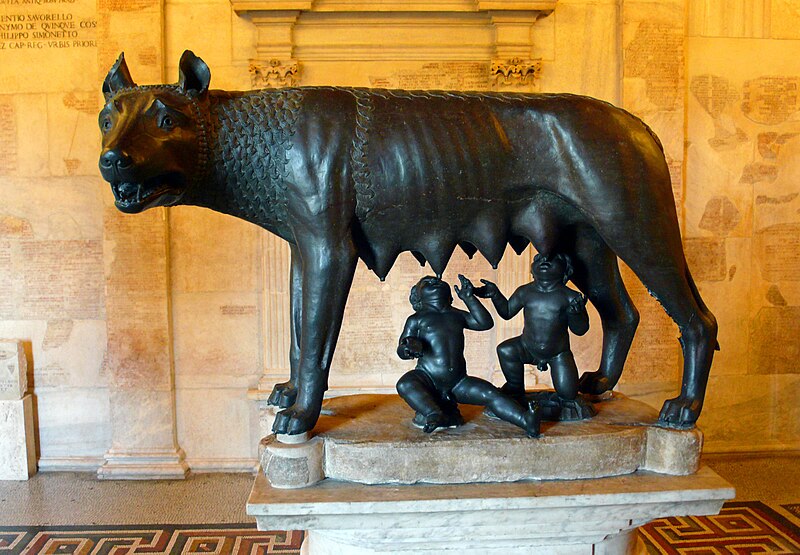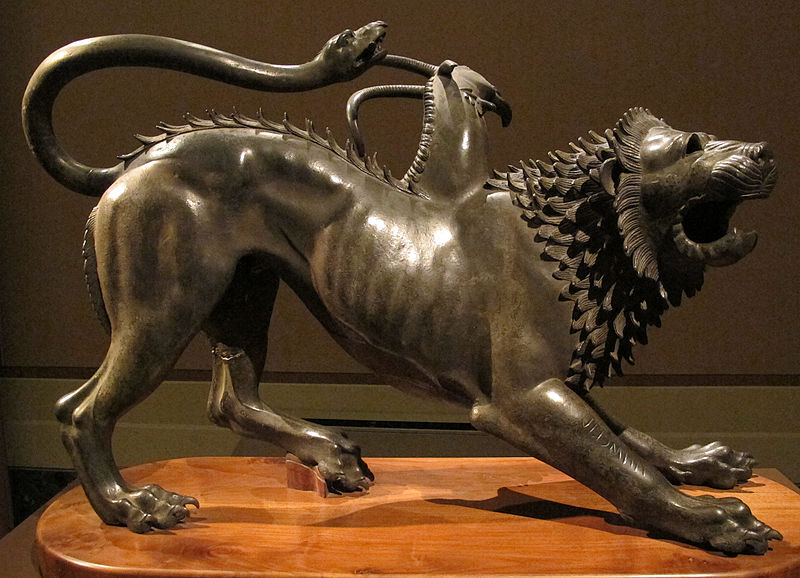I don't recall when I first saw the Capitoline Wolf, but it wasn't in one of those earliest art-discovering experiences. I'd seen the Discobolos and Venus de Milo a thousand times before ever encountering it. I'd learned a handful of ancient Egyptian gods and wondered at Greek black figure and red figure pottery. I knew the story of Romulus and Remus before ever seeing the statue that celebrates their infancy.
I was probably 12 or so when I first did see the sculpture labeled as ancient Roman (supposedly, from around 500 BC). It struck me as odd compared to everything I'd seen before. Maybe it was the surprised look on the wolf's face, or the clunky pose, with its back completely strait from head to hindquarters. Or maybe it was the far more fleshy and lively babies below, who certainly looked like the product of a different hand. I couldn't have put any of these things into words at the time, but somehow the sculpture just didn't fit, either with itself or with any other art I knew.
So when I read something a few weeks ago purporting that the sculpture is really a Romanesque/Renaissance creation, I was surprised at first. Then, it made a lot more sense. Evidently science has dated the Romulus and Remus figures to the late 1400s (don't they look like chubby Renaissance cherubs?). And, though results haven't come back concerning the wolf, a study of stylistic cues suggests she belongs to the Romanesque period.
The original presumption that the Capitoline Wolf was an Early Roman or Etruscan work was based on visual similarities, such as the presentation of the fur, with authentic Etruscan works like the famed Chimera of Arezzo (from 400 BC).

The Capitoline Wolf, 480-500 BC. Or, 1200s and 1400s.

The Chimera of Arezzo, 400 BC. (Tail is an 18th century restoration.)
With just these two examples to look at, similarities do stand out. It's hard to imagine that one doesn't derive from the other in some way. But, take a look at this Romanesque lion and compare all three:

Lion, Mainz Cathedral, Germany, Romanesque
To me it's interesting that the Mainz lion's face has so much in common with the Chimera's--the lines on the snout and the jowly mouth, for instance. Although the rest of the anatomy is decidedly different--look at the paws, or the blocks of muscle on the Mainz lion that are much smoother and more contoured on the Chimera. Look at the mane, flattened down on the Mainz lion and standing out at all angles on the Chimera. And the pose: the Chimera matches up with what we expect of art in the Early Roman period in that it's dynamic and expressive, while the Mainz lion is quite Romanesque in deportment. Solid, staid, and stately.
Put between these two lions, where does the Capitoline Wolf fit? It's easy to see more visual similarities to the Mainz lion--the stiffly shaped muscles, solid pose, and flat, curly mane are all comparable. And though I don't know a lot about bronze casting technology from either of these time periods, I would have to say that not only the aesthetic preferences of the time periods are evident, but also the abilities of the medium. Clearly the creator of the Chimera had a level of bronze-working technology that didn't exist in the Romanesque period, to pick out the bristling mane and veins bulging on the body and legs. These sorts of details are often seen in Roman sculpture, and I can't think of a single Romanesque sculpture with them.
If I had all the time in the world I'd delve deeper into this topic and learn everything there is to know--as it is, I don't. And yet, it just so happens that I'm signed up for a Romanesque Art History class for Fall term, starting next week. Looks like I already have a topic for my final paper!
No comments:
Post a Comment